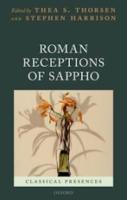
Oxford (2019) h/b 480pp £90 (ISBN 9780198829430
Sappho (fl. 600 BC) is widely recognised as the greatest woman poet of antiquity. Only a few fragments survive, but in 2004 the University of Cologne acquired the remnants of two papyri. Excerpts published in 2016 have added dramatically to our knowledge of her life and work. The ‘Brothers’ song bears out Herodotus’s account of Sappho’s disapproval of her brother’s expensive love affair. In the ‘Kypris’ song the pain of love makes Sappho weak at the knees. Fragment 58 on ageing is enlarged. The ‘Posthumous Honour for Sappho’ has emerged in which she notes her fame as a sweet-sounding swallow.
Roman Receptions of Sappho consists of 15 essays which now reassess Sappho’s influence on the classical Roman poets, enabling us to re-engage with her known oeuvre while making new discoveries. T. contributes an Introduction and five chapters, including essays on Sapphic references in Catullus, Horace and Ovid. She rightly challenges the ‘orthodoxy’ that Ovid was not the author of Heroides 15, Sappho’s letter to Phaon, and adduces parallels with Sappho’s fr. 15, fr. 5, The ‘Brothers’ song and the ‘Kypris’ song. There are two further chapters on Ovid. Jennifer Ingleheart focuses on the ‘lascivious’ sex-counsellor portrayed by Ovid. Chiara Elisei compares the pain of love in Heroides 15 with fr. 94 τεθνάκην δ’ ἀδόλως θέλω (‘Truly I wish I were dead’) and considers Sappho as a forerunner to the Heroides and the Ars Amatoria.
H. is both mentor to the project and author of a chapter on Virgil, in which he identifies Virgil’s Vesper in the Eclogues and Georgics with Sappho’s evening star Hesperos. Richard Hunter elaborates on the reception of Sappho 31 (‘φαίνεταί μοι κῆνος ἴσος θέοισιν’) in Catullus 51 (Ille mi par esse deo videtur) and Lucretius 3.152-60. Olivier Thévenaz sees Sapphic echoes in Catullus 1-14. Sappho’s wedding song (fr. 105) likens the bride to a hyacinth trampled by shepherds in the mountains (οἴαν τὰν ὐάκινθον ἐν ὤρεσι ποίμενες ἄνδρες | πόσσι καταστείβοισι); in Catullus 11, lost love falls like a flower in the furthest part of the meadow after it has been touched by a passing plough (velut prati | ultimi flos, praetereunte postquam | tactus aratro est).
Some of the other contributors struggle to make a case for Sapphic reception by their allotted Roman poets. In chapter 3, Lucretius’s Venus is the generative force; Sappho’s Aphrodite creates not life but the agony of passion. The link is unproven. Chapter 5 argues that Catullus’s Lesbia relates to Sappho as Muse, when the name may purely be a pseudonym for Clodia. Chapter 14 on Roman Epigram draws a similar result. Martial refers to Sappho in three poems, but responds to her as a ‘character’, not as a poet. In chapter 8, subtitled ‘The Case of Horace’, Richard Hunter suggests in a second essay that Horace ‘inverted the prayer of … Sappho (poem 1)’ in Odes 4.1, but elsewhere ‘the verbal links are perhaps not strong enough’, though reddas incolumem precor (Odes 1.3.7: ‘may you return unharmed’) echoes ἀβλάβην (‘unharmed’) in Sappho’s prayer for her brother’s safe return (fr. 5.1-4). It is a pity not to find a chapter on Sappho’s metres and Horace’s reception of them.
The title of chapter 10 ends with a question mark: ‘Sappho in Propertius?’ Propertius refers to Sappho only once, indirectly, when Cynthia ‘attempts songs with an Aeolian plectrum.’ The contributor sees no direct relationship between the Tithonus of Sappho (fr. 58) and that of Propertius (2.18.5-20), but a ‘very obvious pairing’ between Horace Odes 1.17.21-2 and Sappho which he marks in bold: Hic innocentis pocula Lesbii | duces ‘You can drink cups of harmless Lesbian here’, i.e. ‘you can enjoy poetry in imitation of Sappho and Alcaeus in this book.’
This supposed link is implausible. Horace’s point, as Nisbet and Hubbard note, is that Lesbian wine did not go to the head. Horace invites Tyndaris to sip it in the shade (sub umbra), not in a book. Its lightness will prevent Bacchus from joining forces with Mars and avoid the risk of sexual harassment by Cyrus. The volume containing this Ode was not published until 23 BC.
There are some other points of translation to question. For example, cervus (p. 173) is a stag or deer, lucet papilla (p.185) refers to a nipple peeking through, duro sidere (p. 193) implies adverse rather than dark, ne (p.234) means ‘lest’, not ‘unless’, and pullus (p. 235) is dark grey. On page 186, the contributor has substituted cerno for the Oxford text, and changed sine arte to sine aere despite Heroides 4.77.
This is a thoroughly worthwhile book and a credit to the two editors. It will reinvigorate everyone with an interest in the first feminist poet.
Stuart Lyons
